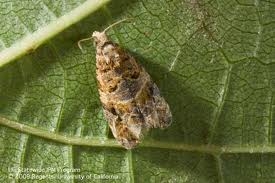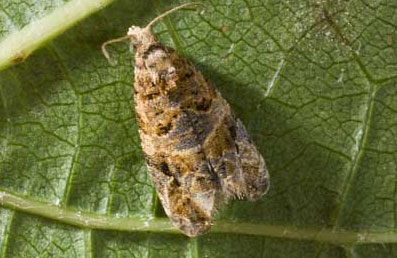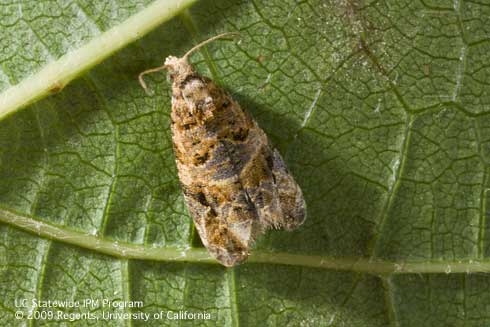Posts Tagged: European grapevine moth
Sonoma County grape growers face a triple threat
“Invasive pests are a problem,” said Nick Frey, president of the Sonoma County Winegrape Commission. “They threaten California agriculture in general, and probably our ecology too, so it’s important to try to prevent their import into the state, and if they do get here, to detect them early. If you don’t get early detection, your odds of eradication are low.”
Rhonda Smith, UC Cooperative Extension advisor in Sonoma County, said local citizens also need to understand and comply with rules to prevent the introduction and spread of invasive species.
“The bottom line is, follow the rules,” Smith said, “because ultimately, the result is pretty dramatic. And who pays the price for that? We pay the price for the enormous effort to eradicate something once it’s here, and/or, we completely lose that industry. We then begin to eat more fruits and vegetables we don’t grow here in California.”
'Two-way learning' embraced
Tim Hearden, Capital Press
Rick Buchner, UC Cooperative Extension advisor in Tehama County, was featured as a "Western Innovator" in a Capital Press story published yesterday. In the article, he explained how the UCCE two-way learning model - involving UC academics and farmers - has been successful in solving agricultural problems.
"The beauty of extension is that we all learn together," Buchner said. "The growers know things that I don't, and I hopefully can share things from the university that they don't know. When we work together, it's a pretty powerful team."
UCCE leads the charge against grapevine pest
UC Cooperative Extension farm advisors Monica Cooper and Lucia Varela are taking the lead in helping Napa County growers manage their vineyards infested with European grapevine moth, according to an article in Grower magazine.The advisors are monitoring the pest's lifecycle, and when it's the optimum time for pesticide treatment, they send e-mail alerts to growers.
Growers then have a 10-day window to treat the vineyard, said the article, written by editor Vicky Boyd. The pesticides Intrepid and Altacor are registered for conventional production; Entrust and Bacillus thuringiensis are available for organic farmers.
A second European grapevine moth control effort in Napa County involves distribution of twist-ties on vines to dispense pheromones that disrupt the pests' mating.
In the San Joaquin Valley, where only a few moths have been trapped, agricultural officials are relying on insecticides alone. UC Integrated Pest Management entomologist Walt Bentley told the reporter that clouds of pheromone would shut down detection traps.
“I’m confident we can eliminate it here in the Central Valley,” Bentley was quoted.
For more information, Boyd directs readers to the UC Integrated Pest Management web page on European grapevine moth.

European grapevine moth.
2010 to be rare vintage of Napa 'hobby' wine
Napa County residents who grow a few grapevines to produce homemade wine are being asked to destroy their crop this year to break the life cycle of a pest threatening the county's fabled wine industry, according to an article in the Weekly Calistogan.The European grapevine moth was first detected in the United States in Napa County in 2009. About 1,500 square miles are now under quarantine in Napa, Solano and Sonoma counties, according to the California Department of Food and Agriculture.
The Napa County agricultural commissioner's request that backyard producers voluntarily cut off the fruit and dispose of it does not apply to commercial grape growers, who have been treating their vines to combat the pest for months under the guidance of experts, including the University of California Cooperative Extension, the story said.
One small-scale winegrape grower told reporter Kerana Todorov he considered the request drastic, but probably necessary.
“I understand the commissioner’s concern is with small, urban patches that are hard to monitor and control. I have around a half-acre vineyard in the county with over 20 rows and over 400 vines, and to lose the fruit would be quite a loss," the story quoted John Intardonato.

Feeding damage by European grapevine moth larva.
European grapevine moth funding for growers
At a press conference in Fresno Wednesday, the Natural Resources Conservation Service announced a $1 million cost sharing program to help combat European grapevine moth in California.
The support will cover half the cost of voluntary, environmentally friendly control options, according to the NRCS press release. The pest control strategies, the release said, were developed and approved for use over the past five years by NRCS and the University of California Cooperative Extension. The cost of the treatment is about $208 per acre; NRCS will provide $104 per acre.
"Our intention is to complement the efforts of our partners at CDFA and USDA APHIS who have both the expertise and authority for overseeing infestations of EGVM," NRCS state conservationist Ed Burton is quoted in the release. "We will provide some very targeted Integrated Pest Management tools to farmers who are growing grapes in close vicinity to trapped moths."
Farmers must apply for the funding by June 23.
The Fresno press conference was covered by a number of media outlets, including:
- The Fresno Bee
- KMPH Channel 26 news (Fox affiliate)
- KFSN Channel 30 news (ABC affiliate)
- CBS Channel 47 news
The press conference came a day after USDA Animal and Plant Health Inspection Service announced it released an additional $1.75 million in Farm Bill funding to stem the spread of European grapevine moth in California.
Feds provide funding to fight European grapevine moth
The federal government has pledged $1.75 million from the 2008 Farm Bill to fight European grapevine moth, a pest that made its first recorded U.S. appearance last September in a Napa County vineyard. EGVM has since spread to six grape-producing counties, according to the California Department of Food and Agriculture.
"After increased detections of the pest in California in recent weeks, it is clear that additional funding is needed to ensure we can respond quickly and effectively to protect California's grape and wine industries," USDA administrator Cindy Smith was quoted in the Fresno Bee article about the new funding. The money will be used for trapping, detection and surveying of the pest.
Growers are currently using low toxicity pesticides to combat EGVM, according to the San Francisco Chronicle's Inside Scoop blog. CDFA has has approved two materials for use in vineyards with EGVM and CCOF, which provides organic certification to growers, has approved ISO-Mate EGVM, a pheromone treatment used to confuse adult male moths in search of a mate.However, UCCE Napa County viticulture advisor Monica Cooper says it's too soon to know how well the treatments will work, according to the blog. Several trials are under way.
UCCE European grapevine moth fact sheet.

European grapevine moth.

